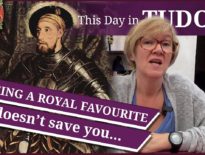On this day in history, 7th February 1477 or 1478, Sir Thomas More, Henry VIII's Lord Chancellor, was born in London.
More had once wanted to be a monk but ended up being one of the most well-known statesmen of the Tudor period. Unfortunately, Sir Thomas More came to a sticky end after refusing to sign the oath recognising Henry VIII as the supreme head of the church in England, and was executed in 1535 as a traitor.
Find out all about More's rise to power, how he fell, and what he told his son-in-law about the king, in today's talk.
Also on this day in Tudor history, 7th February 1526, Henry VIII took part in the traditional Shrovetide joust at Greenwich. I tell you all about it, and also about a nasty accident that one courtier suffered at it, in last year’s video:
Further videos on Sir Thomas More:
Also on this day in history;
- 1531 - Convocation ordered to recognise Henry as “sole protector and supreme head of the English church and clergy”. The resulting “haggling” results in Thomas Cromwell adding the phrase “so far as the law of Christ allows”.
- 1587 – Sir Amyas Paulet read out Mary, Queen of Scots' death warrant to her, and informed her that she would be executed the following day.
- 1591 – Burial of Sir Nicholas Bagenal (Bagnal), soldier and Marshal of the army in Ireland in the reigns of Edward VI and Elizabeth I. He was buried at Newry.
- 1594 – Death of Barnabe Googe, pastoral poet and translator. He was buried at c*ckerington church, near Alvingham. Googe's works included a dedicatory poem in Thomas Gressop's translation of Nicolaus Cabasilas, “A briefe treatise, conteynynge a playne and fruitfull declaration of the popes usurped primacye”, a translation of Zodiacus vitae by Marcellus Palingenius, and his “Eglogs, Epytaphes, and Sonettes”.
- 1623 – Death of Thomas Cecil, 1st Earl of Exeter, courtier, soldier and eldest son of William Cecil, 1st Baron Burghley, probably at Wimbledon. He was buried in the St John the Baptist Chapel, Westminster Abbey. His offices under Elizabeth I included High Sheriff of Northamptonshire, Lord Lieutenant of Yorkshire, Lord President of the Council of the North and Knight of the Garter.
Transcript:
On this day in Tudor history, 7th February 1477 or 1478, Sir Thomas More was born in Milk Street, London. He was the son of Sir John More, lawyer and judge on the King’s Bench, and Agnes Graunger, daughter of Thomas Graunger, a Merchant of the Staple of Calais and an Alderman of London.
More joined the household of John Morton, Archbishop of Canterbury, before studying Latin and logic at the University of Oxford. He then studied law in London. It was while he was a student that he met and became friends with men like William Lilye, John Colet and Erasmus.
Between 1499 and 1503, More stayed at the Carthusian priory, London Charterhouse, while he considered joining the order. He also considered becoming a Franciscan monk, but decided to devote himself to the law after he realised that a life of celibacy did not suit him. More became a Member of Parliament in 1504, an Undersheriff of the City of London in 1510, a Master of Requests in 1514, one of the King’s counsellors in 1517 and then a Privy Councillor in 1518.
In 1521, Thomas More was knighted and made Undertreasurer after proving himself by carrying out a diplomatic mission to Charles V with Cardinal Wolsey. He rose in influence as the King’s personal secretary and adviser, became Speaker of the House of Commons in 1523, and then the High Steward of the Universities of Oxford and Cambridge. He was appointed the Chancellor of the Duchy of Lancaster in 1525. In 1529, More was made Lord Chancellor after the fall of Cardinal Thomas Wolsey.
More supported the Catholic Church, which he saw as the true faith, and campaigned against the Reformation and heresy. His actions against the Reformation included helping Cardinal Wolsey to prevent the importation of Lutheran books into England, producing scholarly works against Luther’s writings and persecuting people whom he perceived as heretics. His non-religious scholarly work included “History of King Richard III” and “Utopia”.
He was a loyal servant of King Henry VIII, but ended up being executed as a traitor on 6th July 1535 after being found guilty of “traitorously attempting to deprive the king of his title of supreme head of the church”. More believed that “no temporal man may be the head of spirituality”, even his beloved king. More had been a father figure to King Henry VIII, but was under no illusions concerning the king, remarking to his son-in-law, William Roper, after Roper had noted how fond the king was of More,“if my head could win him a castle in France, it should not fail to go.”
More is famous as St Thomas More, after being beatified in 1886 and canonised in 1935. His feast day is celebrated on 22nd June in the Roman Catholic Church and 6th July in the Anglican Church.



He is the patron saint of politicians. Well someone has to be. He was a great scholar and statesman, very well respected nationally and internationally and was Henry’s mentor. His death was a great betrayal of everything he had taught him.